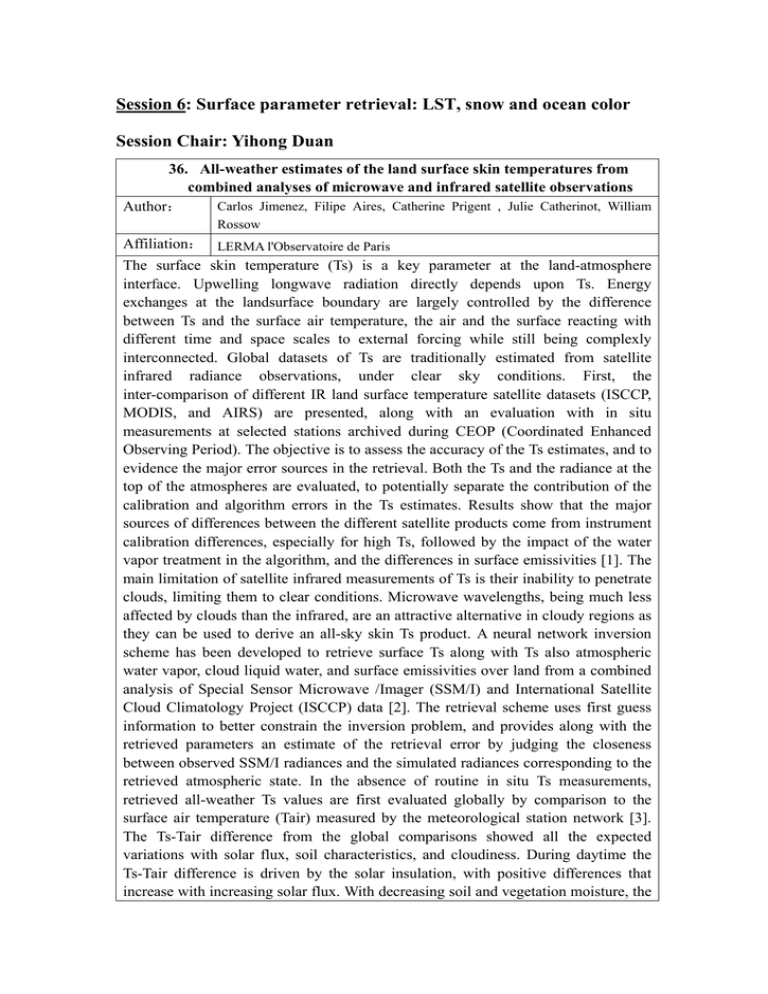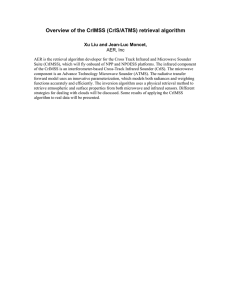Session 6: Surface parameter retrieval: LST, snow and ocean color
advertisement

Session 6: Surface parameter retrieval: LST, snow and ocean color Session Chair: Yihong Duan 36. All-weather estimates of the land surface skin temperatures from combined analyses of microwave and infrared satellite observations Carlos Jimenez, Filipe Aires, Catherine Prigent , Julie Catherinot, William Author: Rossow Affiliation: LERMA l'Observatoire de Paris The surface skin temperature (Ts) is a key parameter at the land-atmosphere interface. Upwelling longwave radiation directly depends upon Ts. Energy exchanges at the landsurface boundary are largely controlled by the difference between Ts and the surface air temperature, the air and the surface reacting with different time and space scales to external forcing while still being complexly interconnected. Global datasets of Ts are traditionally estimated from satellite infrared radiance observations, under clear sky conditions. First, the inter-comparison of different IR land surface temperature satellite datasets (ISCCP, MODIS, and AIRS) are presented, along with an evaluation with in situ measurements at selected stations archived during CEOP (Coordinated Enhanced Observing Period). The objective is to assess the accuracy of the Ts estimates, and to evidence the major error sources in the retrieval. Both the Ts and the radiance at the top of the atmospheres are evaluated, to potentially separate the contribution of the calibration and algorithm errors in the Ts estimates. Results show that the major sources of differences between the different satellite products come from instrument calibration differences, especially for high Ts, followed by the impact of the water vapor treatment in the algorithm, and the differences in surface emissivities [1]. The main limitation of satellite infrared measurements of Ts is their inability to penetrate clouds, limiting them to clear conditions. Microwave wavelengths, being much less affected by clouds than the infrared, are an attractive alternative in cloudy regions as they can be used to derive an all-sky skin Ts product. A neural network inversion scheme has been developed to retrieve surface Ts along with Ts also atmospheric water vapor, cloud liquid water, and surface emissivities over land from a combined analysis of Special Sensor Microwave /Imager (SSM/I) and International Satellite Cloud Climatology Project (ISCCP) data [2]. The retrieval scheme uses first guess information to better constrain the inversion problem, and provides along with the retrieved parameters an estimate of the retrieval error by judging the closeness between observed SSM/I radiances and the simulated radiances corresponding to the retrieved atmospheric state. In the absence of routine in situ Ts measurements, retrieved all-weather Ts values are first evaluated globally by comparison to the surface air temperature (Tair) measured by the meteorological station network [3]. The Ts-Tair difference from the global comparisons showed all the expected variations with solar flux, soil characteristics, and cloudiness. During daytime the Ts-Tair difference is driven by the solar insulation, with positive differences that increase with increasing solar flux. With decreasing soil and vegetation moisture, the evaporation rate decreases, increasing the sensible heat flux, thus requiring larger Ts-Tair differences. Nighttime Ts-Tair differences are governed by the longwave radiation balance, with Ts usually closer or lower than Tair. The presence of clouds dampens all the difference. The Ts evaluation has been recently extended locally at a few sites by using the Ts in-situ measurements from several CEOP stations representing different biomes. The ISCCP infrared Ts estimates, the derived microwave Ts, and a different microwave Ts estimate obtained by a linear regression with the 37 GHz measured radiances [4], are compared for selected months in 2003. Under clear sky conditions, the quality of our microwave neural network retrieval is equivalent to the infrared ISCCP products, for most in situ stations. For a given location, the performance of the microwave algorithm is similar under clear and cloudy conditions, confirming the potential of the microwave Ts retrieval under clouds. The accuracy of the Ts estimate does not depend upon the surface emissivity, as the variability of this parameter is accounted for in the processing. Our microwave Ts estimates have been calculated for more than 15 years (1993-2008). These “all weather” Ts estimates are a very valuable complement to the IR-derived Ts, for use in atmospheric and surface models. [5] [1] Jimenez, C., C. Prigent, J. Catherinot, W. B. Rossow, Comparison of AIRS, MODIS, and ISCCP land surface températures, to be submitted to GRL, 2011. [2] Aires, F., C. Prigent, W. B. Rossow, M. Rothstein, A new neural network approach including first-guess for retrieval of atmospheric water vapor, cloud liquid water path, surface temperature and emissivities over land from satellite microwave observations, J. Geophys. Res., 106, 14 887-14 907, 2001. [3] Prigent, C., F. Aires, and W. B. Rossow, Land surface skin temperatures from a combined analysis of microwave and infrared satellite observations for an all-weather evaluation of the differences between air and skin temperatures, J. Geophys. Res., 108, 4310-4321, 2003. [4] Holmes, T. R. H., R. A. M. De Jeu, M. Owe, and A. J. Dolman, Land surface temperature from Ka band (37 GHz) passive microwave observations, J. Geophys. Res., 114, D04113, doi:10.1029/2008JD010257, 2009. [5] Catherinot, J., C. Prigent, R. Maurer, F. Papa, C. Jimenez, F. Aires, W. B. Rossow, Evaluation of ’all weather’ microwave-derived land surface temperatures with in situ CEOP measurements, submitted to JGR, 2011.





